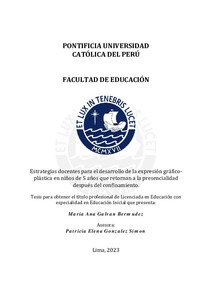| dc.contributor.advisor | Gonzalez Simon, Patricia Elena | |
| dc.contributor.author | Galvan Bermudez, Maria Ana | |
| dc.date.accessioned | 2023-07-31T16:38:39Z | |
| dc.date.available | 2023-07-31T16:38:39Z | |
| dc.date.created | 2023 | |
| dc.date.issued | 2023-07-31 | |
| dc.identifier.uri | http://hdl.handle.net/20.500.12404/25480 | |
| dc.description.abstract | La expresión gráfico-plástica es comprendida como una forma de comunicación de
sentimientos y emociones. Le brinda al infante diversas oportunidades para
relacionarse y comprender su entorno más cercano. Por tal motivo, es relevante que
se estimule y promueva desde edades tempranas como parte de la educación de los
niños. Sin embargo, a raíz del confinamiento provocado por la pandemia del COVID-
19, las escuelas brindaron clases a distancia por alrededor de dos años. Este nuevo
contexto supuso diversos cambios en las formas de enseñar la gráfico-plástica. Por
tal motivo, se consideró importante analizar las estrategias que usan las docentes
para el desarrollo de la expresión gráfico-plástica en niños de 5 años que asisten a
clases presenciales después del confinamiento. Así como también, conocer cuáles
son las características de estos niños, a nivel gráfico-plástico, en su primer año de
escolarización presencial. De la misma forma, cabe destacar que el presente trabajo
de investigación posee un enfoque cualitativo de tipo descriptivo, por lo que se
resaltan los testimonios de las informantes y los trabajos gráfico-plásticos de los
niños, lo cual permite realizar una triangulación oportuna de la información. Por
último, la investigación concluye que la expresión gráfico-plástica facilitó el retorno a
la presencialidad debido a que los niños tuvieron la oportunidad de expresar sus
vivencias con libertad y en un entorno de contención seguro. | es_ES |
| dc.description.abstract | Graphic-plastic expression is understood as a form of communication of feelings and
emotions. It provides children with various opportunities to relate to and understand
their immediate environment. For this reason, it is important to stimulate and promote
it from an early age as part of children's education. However, because of the
confinement caused by the COVID-19 pandemic, schools provided distance learning
for about two years. This new context implied several changes in the ways of
teaching graphic-plastic arts. For this reason, it was considered important to analyze
the strategies used by teachers for the development of graphic-plastic expression in
5-year-old children attending on-site classes after confinement. We also sought to
know what the characteristics of these children are, at the graphic-plastic level, in
their first year of on-site schooling. In the same way, it should be noted that this
research work has a descriptive qualitative approach, so that the testimonies of the
informants and the graphic-plastic works of the children are highlighted, which allows
a timely triangulation of the information. Finally, the research concludes that the
graphic-plastic expression facilitated the return to face-to-face because the children
had the opportunity to express their experiences freely and in a safe containment
environment. | es_ES |
| dc.language.iso | spa | es_ES |
| dc.publisher | Pontificia Universidad Católica del Perú | es_ES |
| dc.rights | info:eu-repo/semantics/openAccess | es_ES |
| dc.rights.uri | http://creativecommons.org/licenses/by/2.5/pe/ | * |
| dc.subject | Arte--Estudio y enseñanza | es_ES |
| dc.subject | Creatividad | es_ES |
| dc.subject | Educación preescolar--Perú--Investigaciones | es_ES |
| dc.title | Estrategias docentes para el desarrollo de la expresión gráfico-plástica en niños de 5 años que retornan a la presencialidad después del confinamiento | es_ES |
| dc.type | info:eu-repo/semantics/bachelorThesis | es_ES |
| thesis.degree.name | Licenciado en Educación con especialidad en Educación Inicial | es_ES |
| thesis.degree.level | Título Profesional | es_ES |
| thesis.degree.grantor | Pontificia Universidad Católica del Perú, Facultad de Educación | es_ES |
| thesis.degree.discipline | Educación con especialidad en Educación Inicial | es_ES |
| renati.advisor.dni | 07232630 | |
| renati.advisor.orcid | https://orcid.org/0000-0003-2020-4169 | es_ES |
| renati.author.dni | 72029115 | |
| renati.discipline | 111016 | es_ES |
| renati.juror | Iturria Hermoza, Angela Mercedes Aurora | es_ES |
| renati.juror | Nakamura Goshima, Patricia Eileen | es_ES |
| renati.juror | Lamas Basurto, Pilar Luzmila | es_ES |
| renati.level | https://purl.org/pe-repo/renati/level#tituloProfesional | es_ES |
| renati.type | https://purl.org/pe-repo/renati/type#tesis | es_ES |
| dc.publisher.country | PE | es_ES |
| dc.subject.ocde | https://purl.org/pe-repo/ocde/ford#5.03.01 | es_ES |







